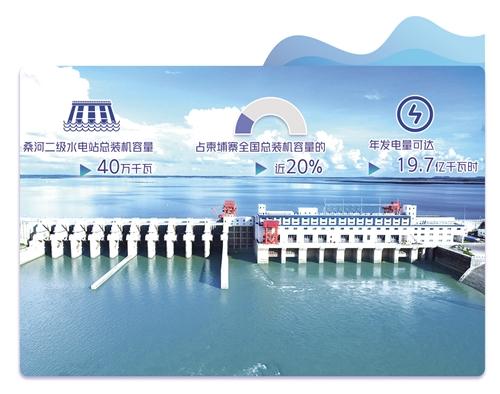Sanhe
II Hydropower Station-
Rewriting the history of electricity consumption in Cambodia
Our reporter Yuan Yong
The Sang River II Hydropower Station in Cambodia.
(Profile picture)
The Mekong River twists and turns, flows into Cambodia from north to south, and stretches out a tributary-the San River in Stung Treng Province in northeastern Cambodia.
Above the San River, a dam with a total length of 6,500 meters stands across. This is Cambodia's largest hydropower project at present-the San River II Hydropower Station.
The power station is controlled by China Huaneng Group Co., Ltd., which has realized the "full chain" of Chinese technology, Chinese standards, Chinese equipment, and Chinese management.
Li Mengsen, the chief representative of China Huaneng in Cambodia, said in an interview that the Sanhe II Hydropower Station is the first renewable energy power generation project that China Huaneng has invested and constructed in Cambodia in actively responding to the national “One Belt One Road” initiative. It is a green, low-carbon, and Eco-friendly power station.
The power station has excellent engineering quality, fast construction speed, and good production efficiency, reaching the world's advanced level.
Since its commissioning, the problem of insufficient electricity supply in Cambodia has been greatly alleviated.
Cambodia is rich in water resources, but due to its limited development capacity, it faces the problems of insufficient power supply and dependence on imports.
On October 21, 2018, the Sanhe II Hydropower Station completed the commissioning of all units to generate electricity, rewriting the history of electricity consumption in Cambodia.
The Sanhe II Hydropower Station has a total installed capacity of 400,000 kilowatts, accounting for nearly 20% of Cambodia's total installed capacity, with an annual power generation capacity of 1.97 billion kilowatt-hours, completely reversing Cambodia's heavy dependence on imported foreign power.
On the day of the commissioning ceremony, the Cambodian government announced that it would reduce the price of electricity for industry and residents across the country, and the cost of electricity for the people has dropped significantly.
The Cambodian side attaches great importance to this project. The mainstream Cambodian media "Khmer Times" stated: "The commissioning and operation of the power station is a symbol of Cambodia's energy independence." The River II Hydropower Station is a model project of China-Cambodia energy cooperation. It has solved many problems in Cambodia’s development, and has further promoted the development of Cambodia’s industry, agriculture, manufacturing, and tourism services. It has contributed to Cambodia’s energy security, lower electricity prices, and poverty reduction. An important contribution.
What Hun Sen said is true.
The “Chinese-style” poverty alleviation experience brought about by the construction of the power station has directly contributed to the overall relocation of 840 households and 3,690 poor people in the surrounding area. It is the largest immigration relocation project in Cambodia's history.
With the active efforts of China Huaneng, the immigrant village in the reservoir area has been built into a Sino-Cambodian friendship demonstration village.
The resettlement village has determined 3 resettlement sites. The new resettlement houses are also divided into wooden houses and brick-concrete houses. The resettlement locations and methods fully respect the wishes of local villagers to meet the production and living needs of different people.
In order to improve the quality of life of residents, the resettlement sites have also built domestic water wells, roads, power transmission lines, etc., and equipped with public infrastructure such as schools and hospitals.
The project also regularly provides villagers with relevant skills training and assistance, and introduces the "company + farmer" model to help villagers sell agricultural products and help local villagers gradually get rid of poverty and backwardness.
In order to cultivate local talents, Sanghe Hydropower Company has formulated a 15-year plan for training Cambodian electrical engineers, detailed training content and job promotion standards, and arranged for experienced Chinese engineers to sign mentorship agreements with Cambodian engineers to conduct "one-to-one". The guidance starts with understanding the equipment, familiarizing with the factory building, and learning the basic knowledge of electric power, and finally trains Cambodian engineers into senior management talents with systematic analysis, judgment, and problem-solving capabilities. At present, more than 20 electric power engineers have been trained for Cambodia.
In the process of project construction and operation, environmental protection issues have always been placed at a crucial position.
In order to meet the flow demand of the ecological environment of the river downstream of the dam, the project has set up flow observation points to ensure the discharge flow through reasonable scheduling.
For the waste water generated by the project, the recyclable waste water is filtered by the water purification equipment and used for irrigation, sprinkling and dust reduction and equipment site washing in the green belt of the system. The water quality of the river upstream and downstream of the dam was tested.
In addition, Sanghe Hydropower Company also stipulates that it is strictly forbidden to dump waste into the river, strengthen management of construction personnel, and publicize fish protection laws and regulations.
In order to meet the needs of a variety of long-distance migratory fish in the project area, the company invested about 1.5 million US dollars to add a bionic fish channel on the right bank of the power station, which not only provides a migration route for fish passing through the hydropower station, but also serves as an ecological corridor. It has become a viewing area for locals to appreciate the spectacle of fish migrating upstream and spawning.
Yuan Yong

